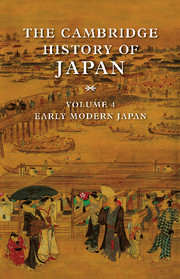Book contents
- Frontmatter
- 1 Introduction
- 2 The sixteenth-century unification
- 3 The social and economic consequences of unification
- 4 The bakuhan system
- 5 The han
- 6 The inseparable trinity: Japan's relations with China and Korea
- 7 Christianity and the daimyo
- 8 Thought and religion: 1550–1700
- 9 Politics in the eighteenth century
- 10 The village and agriculture during the Edo period
- 11 Commercial change and urban growth in early modern Japan
- 12 History and nature in eighteenth-century Tokugawa thought
- 13 Tokugawa society: material culture, standard of living, and life-styles
- 14 Popular culture
- Works Cited
- Index
- Provinces and regions of early modern Japan
- References
4 - The bakuhan system
Published online by Cambridge University Press: 28 March 2008
- Frontmatter
- 1 Introduction
- 2 The sixteenth-century unification
- 3 The social and economic consequences of unification
- 4 The bakuhan system
- 5 The han
- 6 The inseparable trinity: Japan's relations with China and Korea
- 7 Christianity and the daimyo
- 8 Thought and religion: 1550–1700
- 9 Politics in the eighteenth century
- 10 The village and agriculture during the Edo period
- 11 Commercial change and urban growth in early modern Japan
- 12 History and nature in eighteenth-century Tokugawa thought
- 13 Tokugawa society: material culture, standard of living, and life-styles
- 14 Popular culture
- Works Cited
- Index
- Provinces and regions of early modern Japan
- References
Summary
The political structure established by the Tokugawa house in the early years of the seventeenth century is now commonly referred to as the bakuhan system (bakuhan taisei). This term, coined by modern Japanese historians, recognizes the fact that under the Edo bakufu, or shogunate, government organization was the result of the final maturation of the institutions of shogunal rule at the national level and of daimyo rule at the local level. Although Tokugawa Ieyasu became shogun in 1603, it was not until the years of the dynasty's third shogun, Iemitsu, that the Edo bakufu reached its stable form, that is, not until the 1630 and 1640s. And it took another several decades before the han, or daimyo domains, completed their evolution as units of local governance. Scholars now agree, however, that most of the institutional components of the bakuhan system had made their initial appearance under the first two of the “three great unifiers,” Oda Nobunaga and Toyotomi Hideyoshi.
This chapter will trace the formation and the evolution of the bakuhan structure of government from the middle of the sixteenth century to the end of the eighteenth century. Because the following chapters will treat separately the daimyo domains as units of local administration, the primary emphasis of this chapter will be the Edo shogunate and the nationwide aspects of the bakuhan system. As noted in the introduction to this volume, historians increasingly identify the broader dimensions of shogunal rule by using the concept of kokka (nation or state) to replace taisei (system), thus coining the expression bakuhansei-kokka (the bakuhan state).
- Type
- Chapter
- Information
- The Cambridge History of Japan , pp. 128 - 182Publisher: Cambridge University PressPrint publication year: 1991
References
- 8
- Cited by

